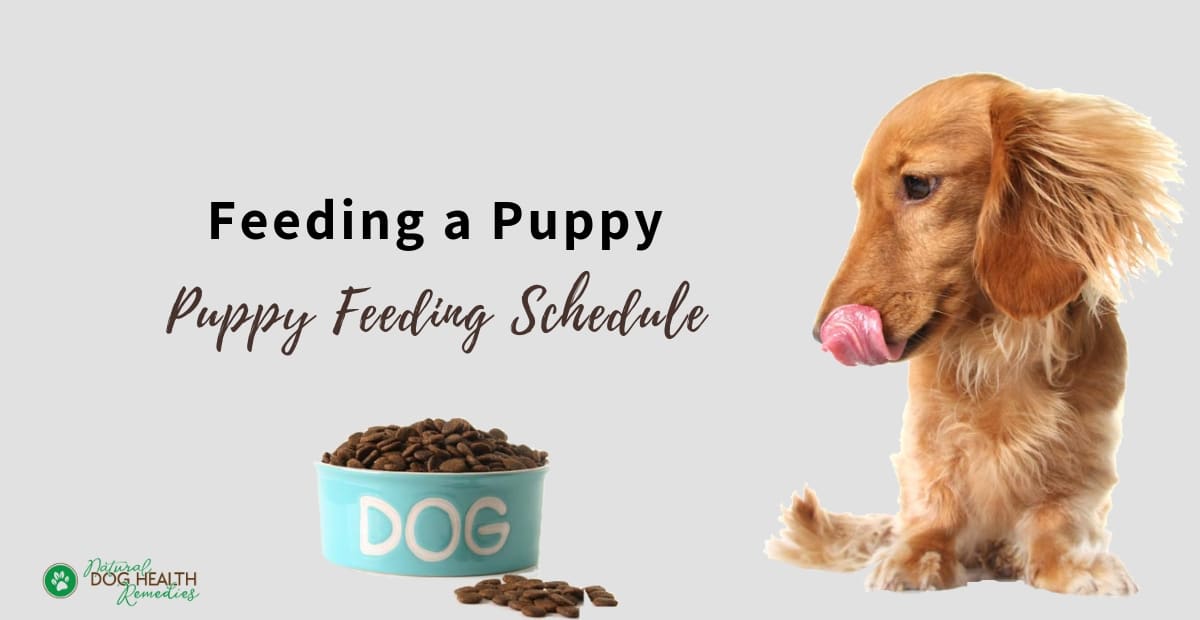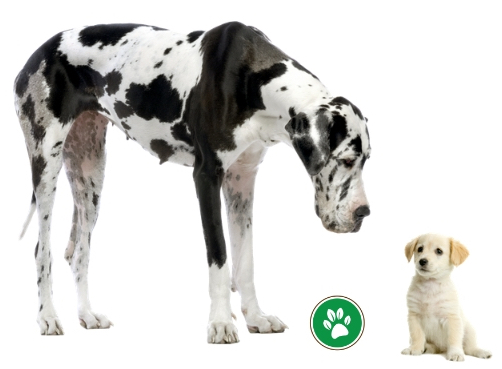Feeding a Puppy & Feeding Schedule
(FTC Disclosure: If you make a purchase via a link on this page, I may receive a small commission, at no added cost to you.)

Overview
Just like human babies, puppies need special food and a more regular feeding schedule. Also, what we feed to the puppy and how much we feed her will decide how well and healthy she is while growing up and thereafter.
It is therefore very important for new puppy parents to learn more about things related to feeding a puppy, such as natural healthy puppy food, and puppy feeding schedule.
This page looks at the following:
- What is a good puppy feeding schedule?
- How much should we be feeding a puppy?
- What kind of food should we be feeding our puppy?
- Should different breeds be fed differently?
- How can we tell if the food is suitable for our puppy?
- Should we give our puppy treats?
- Some puppy feeding tips
Feeding a Puppy Following a Puppy Feeding Schedule
When you get a new puppy, you should set a puppy feeding schedule that fits into your daily routine so that you can incorporate potty training into the schedule as well. By feeding a puppy on a set schedule, the puppy will go to the bathroom more regularly, making potty training easier and faster.
As a general rule of thumb, very young puppies should be fed more often that older puppies.
Here is a rough guideline of a puppy feeding schedule. For puppies who are:
- 6 to 12 weeks - 4 times a day;
- 13 weeks to 6 months - 3 times a day;
- older than 6 months - 2 times a day.
One of the most important things to remember when it comes to feeding a puppy is: Do not leave food down all the time, and there are good reasons for that. For example:
- One common puppy and dog illness symptom is appetite loss. But if there is always food in your puppy's dish, it will be hard to notice whether she has lost her appetite, won't it?
- In addition, food spoils (even dry dog food can go rancid), especially on a hot summer day. Spoiled food can most definitely make a puppy sick.
Finally, make it a habit to encourage your puppy to go to the bathroom after each meal.
Also, give the puppy some quiet time after each meal. Do not play with her for the first hour or so after eating because your puppy may develop upset tummy that can sometimes be serious.
How Much Should a Puppy be Fed?
Each puppy is an individual with a different metabolic rate, so the amount to be fed to each puppy can vary.
As a general guideline, start off by feeding your puppy a little less than as suggested on the puppy food package. Watch your puppy eat. See how much she eats in about 10-15 minutes for each feeding.
If she finishes all the food in just a few minutes and still looks hungry, give her more within that time frame and up to the suggested amount on the food package. If she leaves any food after 15 minutes, throw it away and give her a little less next meal.
But how do I know if my puppy is eating too much or not enough? You may ask. The answer is simple - watch your puppy's waistline and tummy size.
A healthy, well-fed puppy should be slightly lean, with some cover over the ribs. It is all right to have a bit of puppy fat, but a big round tummy is definitely a no-no - it means that she is overweight. An overweight puppy may look cute but is not healthy and can develop a lot of health problems down the road.
One simple way to check if your puppy is too fat is to try to feel her ribs.
If you can feel her ribs, then she is fine. If you can't feel the ribs, then she is too fat. Usually a fat puppy has a protruding tummy and little or no waistline at all.
Some dog parents think that as a puppy is growing, she needs a lot of food to help her get bigger fast. Actually, we should aim for a moderate growth rate, or even a slightly slower-than-average rate.
The size of an adult dog is genetically determined, and a puppy will reach that size almost regardless of how fast she grows. By slowing down her growth rate, not only does she eat less food, but also - more importantly - she will have better skeletal health.
What Kind of Puppy Food Should We Be Feeding a Puppy?
Unless you have a lot of experience raising puppies, it is advisable to feed your puppy a commercial puppy formula instead of preparing her food at home.
Puppies are growing much faster than adult dogs (20 times faster to be exact), so they need a special, well-balanced diet to aid their physical development.
When choosing a commercial brand of puppy food, we should of course choose one that is natural and of high quality.
The quality of food that she eats determines how well her immune system will develop and therefore how healthy she will be. You do not have to get the most expensive brand of puppy food, but choose the best you can afford.
Typically, you can find three types of commercial dog food for puppies: dry kibble, semi-moist food in sealed packages, and canned puppy food.
A brand of natural, high-quality dry kibble may be the best bet for puppies since both canned foods and semi-moist foods contain more water (55% of water for semi-moist and about 80% for canned), so you are getting less food for your money.
As well, semi-moist foods contain high levels of sugar and salt for preservation - both of which your puppy does not need.
For very young puppies who have difficulty eating dry kibbles, you can soak the kibbles in water for 10 to 15 minutes until soggy. Also, deep-chested large breeds, such as Saint Bernard, or Great Danes, are prone to bloating and pre-moistened kibbles may lower this risk.
Do Breeds and Size Matter When It Comes to Puppy Feeding?
 Breeds and size do matter when it comes to feeding a puppy.
Breeds and size do matter when it comes to feeding a puppy.
If you have a tiny-breed puppy (such as Chihuahua, Maltese, etc.), make sure that they are fed frequently. Four or more feedings a day may be necessary when they are very young.
As you can imagine, the stomach of a tiny-breed puppy is extremely small, so tiny breeds can become hypoglycemic very quickly if they are not fed frequently. Hypoglycemia can lead to coma and death if not treated immediately.
As for large-breed puppies, in the past, many people thought that growing puppies of larger breeds needed to have more calcium, phosphorus, protein and calories, but now it has been found that the opposite is true.
Large-breed puppies actually need less calcium so their bones can develop normally. By reducing the calcium and controlling the calories in diets for large-breed puppies, and therefore preventing them from growing too fast, we could actually help them grow with fewer skeletal problems.
How Can We Tell if the Food is Suitable for Our Puppy?
One way to tell if a diet is suitable for your puppy or not is to look at her poop.
If your puppy can digest her food well (i.e. the food is suitable for her), her poop should be solid, well-formed, and dark brown in color.
But if your puppy has soft poop or is always having gas or diarrhea, then the diet may not be a suitable one for her. You may want to consult with your vet and try to change her diet.
If you do have to change her food, do not make the change in one day as this may cause tummy upset. Switch the food gradually over a period of 7-10 days.
For each new diet you try, continue for at least 10 days before you make any further changes for whatever reason.
In more serious cases, a puppy may develop allergic reactions towards certain food ingredients. You may notice symptoms such as itchy skin, diarrhea, ear infections, and so on, that are typical symptoms of allergies.
If that happens to your puppy, you need to work with your vet to figure out which food ingredient(s) your puppy is allergic to so that a suitable hypoallergenic diet can be formulated.
How About Feeding a Puppy Dog Treats?
 Treats are good for training and to reward good behavior, but do not give excessive amount to your puppy. If treats contribute over 10% of your pup's calorie intake, then you are giving her too many treats.
Treats are good for training and to reward good behavior, but do not give excessive amount to your puppy. If treats contribute over 10% of your pup's calorie intake, then you are giving her too many treats.
In other words, your puppy's food should be her only main source for the nutrition she needs.
Chew treats that are hard and natural are good for your puppy's gums and teeth, and can keep your energetic puppy busy and occupied for a long time. They also satisfy a teething puppy's need to bite and chew.
Treats that contain sugar are no no's for puppies. (Heck, they are no good for all dogs!) These treats are bad for their teeth as well as their waistline. Also, too much sugar can cause unwanted behavior such as hyperactivity.
Visit our page on Natural Dog Treats for recommendations of different types of good quality treats for your puppy.
Some Tips on Feeding a Puppy
- No matter where your puppy is (inside or outdoors), be sure that she is always supplied with fresh clean water.
- Always throw away uneaten food. Make sure fresh food is given to your puppy at every meal time.
- Do not feed your puppy table scraps because the digestive tracts of young puppies are not fully developed and table scraps could cause digestive problems leading to diarrhea. In addition, if you feed your puppy from the table, she may develop the bad habit of begging later on which can make house training more difficult for you.
- When getting food for your puppy, make sure you get a "complete" food (check the label). A complete food is one that provides all the nutrients required by a puppy (as opposed to a "complementary" food which should never be given as a "stand-alone" to the puppy since it is meant only to complement other foods as it does not contain all the necessary nutrients.)
Eldredge, et al. Dog Owner's Home Veterinary Handbook 4th edition (Wiley Publishing, 2007).
C.J. Puotinen, Natural Remedies for Dogs and Cats (Keats Publishing, 1999).
R.H. Pitcairn, The Complete Guide to Natural Health for Dogs and Cats (Rodale, 2005).
W.J. Dodds, D.R. Laverdue, Canine Nutrigenomics - The New Science of Feeding Your Dog for Optimum Health (Dogwise Publishing, 2015).





